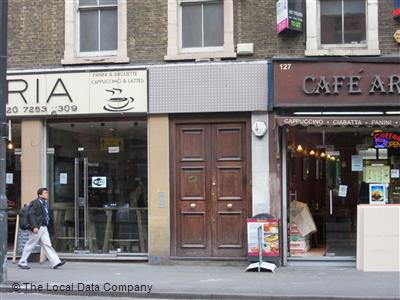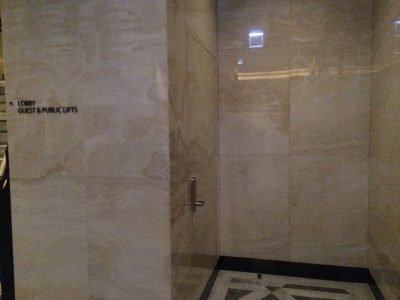
Most bar owners promote their places by placing a sign board outside or updating their menus on social network services such as facebook or instagram. Interestingly however, some bar owners “hide” their doors. I had a chance to visit the bar called Nightjar in London. Surprisingly, it has a super tiny metal sign on a wood door. Therefore, I passed over its entrance door several times and spent many minutes until I decided to knock on it just in case. When the hidden door opened, as expected, this bar was fully packed with drinkers.
I had a similar experience when I first visited the bar called Charles H Bar at the Four Seasons Seoul, Korea. Although this hotel is easy to find, it took me long time again to find the entrance door of the bar. Since this bar has literally no sign outside, I could not help but ask someone to guide me to the entrance door. Again, when the hidden door opened, this bar was crowded.

Why did Nightjar and Charles H Bar decide to hide their entrance doors? At first glance, hiding doors fails to attract by-passers and thus fails to increase traffic, which is important for most spaces. However, this spaces may have different objectives. For instance, they want to make their spaces exclusive only for those who were invited previously. Although there is no research about space exclusivity, there are some studies about the effect of exclusivity promotion or AREP (Advertised as Retailer Exclusive Products). Contrary to managerial expectations, their findings suggest that AREP exclusivity promotions are ineffective at influencing consumers.
***
Reference
Upshaw, D., Amyx, D., Upshaw, A., & Hardy, M. (2023). Do Products Labeled Retailer “Exclusive” Affect Consumer Behavior?. Journal of Marketing Development and Competitiveness, 17(3).
Many large retailers offer “advertised as retailer exclusive products” or AREPs. Retailers work with manufacturers to produce these unique, retailer exclusive versions of otherwise common products. While not all retailer exclusive products are advertised as “exclusive,” AREPs are advertised and labeled as retailer exclusives. The retailer exclusive product attributes are often “trivial,” but still may add customer value and discourage price comparison shopping. Here, two experiments assess AREPs effects on consumers. Contrary to managerial expectations, the findings suggest that AREP exclusivity promotions are ineffective at influencing consumers, but that the choice of exclusive, seemingly “trivial” attribute can sometimes be a significant negative influence on consumers. Further, the authors suggest contexts that may encourage specific responses to retailer exclusive product promotions and trivial attributes.


Speak Easy Bar adopts a secretive and subtle marketing strategy that stimulates consumers’ curiosity through mystery and limited access. By offering unique experiences worth sharing with others, they differentiate themselves in a competitive market. While capturing consumer interest and increasing demand can be an effective marketing tactic, it presents challenges in building brand awareness and interacting with consumers. By intentionally limiting information, Speak Easy Bar highlights its mystique, but this may make it difficult for consumers to obtain sufficient product information. Information scarcity can hinder consumer purchasing decisions and put them at a disadvantage when exploring alternatives from competing products or brands. When launching new products or brands, it is important to communicate with consumers and build awareness, as not being transparent may make it difficult to capture consumer attention in a competitive market. Additionally, consumers form trust in brands through interactions and seek information and opinions when making product or service choices. Strengthening the connection between the brand and consumers through open communication is crucial.
As a contrasting marketing case, we can look at the “Crash the Super Bowl” campaign by Doritos. This campaign provided consumers with the opportunity to create their own advertisements, and the best ad was selected and aired during the Super Bowl halftime. This strategy aimed to promote and expand the awareness of Doritos products and brand. By encouraging and rewarding consumer participation in ad creation, it significantly increased brand awareness and recognition for Doritos. Another example is Red Bull. Red Bull successfully delivers energy and confidence to consumers. They adopt active marketing strategies such as sports sponsorship, advertising campaigns, and active engagement on social media. Their advertising campaigns feature bold and daring activities, emphasizing energy. They promote the brand through extreme sports and large-scale events, expanding awareness of their products, and actively interact with consumers through social media, forming a sense of empathy. These marketing strategies have played a significant role in building consumer loyalty.
Analyzing and comparing the “HIDE DOORS TO BE POPULAR” strategy with its contrasting marketing approach, we can see that each strategy has its own advantages and disadvantages. Speak Easy Bar can evoke interest through mystique, creating a strong desire, but the lack of information creates uncertainty and poses challenges in interacting with consumers. On the other hand, the contrasting strategy emphasizes communication and transparency with consumers. This approach provides consumers with sufficient information about the product or brand, increases interaction, enhances brand trust and customer loyalty, and clearly conveys the brand’s value. When applying marketing strategies, it is important to consider the characteristics and objectives of the product or brand and maintain a balance that allows consumers to obtain sufficient information.
What is one of the basics of marketing? It is exposing your product. The more exposed your product to the general public the more likely that your product is going to have a higher sales number. This case, however, seems to contradict this marketing’s basic. Because it seems that these stores did the opposite of exposing their product(their store) by concealing their store to the passerby, which usually are the main source of sales of any food or drink related stores, yet they still managed to increase their sales. How was this possible? The answer is reputation and curiosity. Even though it may seem that they have avoided marketing activity by concealing their store and removing their sign, this is actually a very clever and psychologically advanced type of marketing. By removing their sign and concealing their store they chose to let their reputation be their strongest ally.
I’m sure most of us have heard the term ‘local spot’; a store that has good products so the locals know them but isn’t so famous that it becomes a must-visit for tourists. These local spots rely heavily on their customers’ ability to ‘spread the word’. It is a very efficient yet very difficult type of promotion strategy as it requires the stores to strictly maintain the quality standard of their many loyal customers for them to spread the word and do the advertising for you, but at the same time if you manage to get them to constantly spread the word, the reward-to-cost ratio is phenomenal. As you would spend way less money on advertising compared to conventional type of advertising like putting up hundreds of posters around the city or buying billboards.
The second part of this marketing strategy is stimulating the potential customers’ curiosity. By building up your store’s reputation, you partially deconstructed your store’s need to constantly having to expose itself to the oncoming passerbys. Usually, not having a sign give the customers impression of confidence, it is like saying to them, ‘We are so great, we don’t sign to operate.’. This impression of confidence makes them curious, makes them wonder whether you’re bluffing or you are actually that good. This impression works like a double-edged sword though. As if your product does not live up to that curious passerby’s expectation, it actually is more likely to backfire and give them a ultimately worse experience compared to if they didn’t have such curiosity-driven expectations.
There is an aspect of adventuring to this too. These spots usually require varying degrees research to locate them. And even if you arrive in the vicinity, you still have to pinpoint them like he did in this case. This is part of the fun however as it is literally an adventure as it requires research, pathfinding and even the reward at the end. It is sort of like egg finding in Easter day but with even greater reward than an Easter day’s egg: a cool new spot to hang out, eat or even brag to your friends.
Sometimes, these signless stores do advertise directly through more contemporary means like social media and such rather than putting up a sign for their store. Which actually makes them reliant on direct advertisement rather than reputation and curiosity like how I mentioned. I hope these cases are not that kind of ‘cheating’ signless shops and actual promote-by-reputation kind of signless shops. Because if it is the former type of store, the whole ‘having no sign’ strategy would just be just a kind of gimmick and not really a main marketing strategy.
Overall, I think this is a very clever, efficient marketing strategy. We live in an age where the brand value completely eclipses actual product value. An age where mass exposure is considered one of the most reliable marketing method. So this to me, feels like a breath of fresh air. This kind of strategy of actually creating special experience for the customer rather than focusing on increasing the exposure of the product to the public, should be the way forward. And I think the future for this method is bright, as consumers are getting smarter and smarter, demanding more social responsibility to corporations. I truly do hope that this movement will eventually bring us the day where corporations survive by truthfully focusing on creating special experience and actual great value for their customers and not just by creating some bloated brand image.